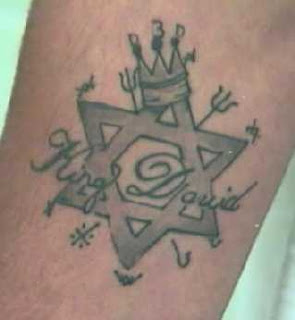A gang signal is a visual or verbal way gang members identify their affiliation. This can take many forms including slogans, tattoos, hand signs and colored clothing. Many of these, especially slogans and hand signs, have become part of popular culture.
The wearer usually favors, or is in, that particular gang. With symbols, graffiti is a large symbol displayed on walls or trains.
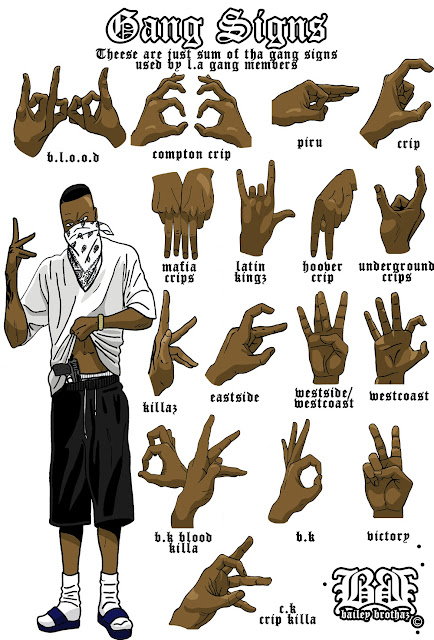 |
| (Gang Signs of Los Angeles) |
(See also Public Enemies: Mexican Cartels)
(See also 25 Notoriously Dangerous Gangs)
(See also Top 10 Biggest Criminal Organizations)
(See also 13 American Gangs That Are Keeping The FBI Up At Night)
Gangs: Slang, Words, Symbols
The Crips and Bloods started as street fighters defending their neighborhoods, only to become more dominant, organized, defined and identifiable in the late 1960s. They evolved into notorious, ultra-violent and criminally successful street gangs, posing a major threat to Los Angeles.
The hundreds of Chicago street gangs and their members, both those incarcerated and on the street, established and aligned themselves with the People and Folk Nations. These four gang nations/affiliations have a presence in the U.S., from the East Coast to the West Coast, and abroad. Several have entrenched themselves with Mexican drug organizations (MDOs), establishing transnational drug distribution networks. All currently pose a threat to public safety throughout the U.S.
Localized criminal street gangs that are directly linked with or emulate established criminal street gangs/gang nations more specifically identify themselves by their “set” names. These names are usually unique, sometimes including the name of the geographic area, neighborhood, street or “turf” in which they live and operate, fror example, the Grape Street Crips (Los Angeles). Each “set” has a varying level of criminal influence in its area of operation.
The Crips, Bloods, People and Folk Nations have many commonly identifiable signs, symbols, clothing items or styles of dress, colors, alphabets and traditions. In addition to the aforementioned street gangs, the 1990s saw the emergence of hybrid and independent street gangs.
No matter how complex some criminal street gangs are, each can be identified and documented. The burden is on the local jurisdiction to have the ability to identify, understand and document gang activity. This documentation must be able to be presented and defended during a criminal proceeding. There is so much gang terminology and symbolism that no one book could centralize and define it all.
Gang Slang/Terms
The following is an abbreviated list of common terms and slang used by street gang members. Terms, slang and graffiti will vary from set to set, from nation to nation, and geographically.
Folk/People Nations
•All is One: Folk Nation gang member greeting another Folk member. •All is Well: People Nation gang member greeting another People member.
•Vicky Lous: Derogatory term to identify the Vice Lords.
•Five in the sky, six must die: People (nation) in heaven, Folks must die.
•Six is high, five must die: Folks have the power and will kill the People.
ADR/Amor de Rey: Love of the King (Almighty Latin King Nation) and a greeting from one Latin King to another.
Donuts: Derogatory term used to identify the Black Gangster Disciples.
Crips/Bloods
•Cuz: Crip gang member greeting or referring to another Crip.
•Scuzz/Crab: Derogatory terms used to identify Crips.
•Slobs: Derogatory term used to identify the Bloods.
•ADDIDAS: All day I diss all slobs.
•What it B like: Blood gang member greeting another Blood.
•What it C like: Crip gang member greeting another Crip.
•Damu: Term for Blood in Swahili.
•Piru (Blood): Name of the street in Compton, Calif., where the Bloods were formed.
General terms
•Gat: A gun.
•Deuce Deuce: A 22 caliber pistol.
•Strapped: Carrying a gun.
•Turf/Kingdom: Gang’s claimed area.
•Slippin: Gang member letting his guard down.
• Put ‘em in check: Discipline or correct a member of the gang.
•Violation: Punishment for a gang member who breaks the rules.
•S.O.S.: Shoot on sight.
•B.O.S.: Beat on sight.
•T.O.S.: Terminate on sight.
•Mad Juice: Respect for.
•Flag/Rag/Heart: Specifically colored bandana used by a gang member to identify with his gang.
Others
•Beat in: A prospect’s initiation into the gang by fighting established members.
•Sex in: A female prospect’s initiation into the gang by having sex with its member(s)/leadership.
•Cheddar/Snaps: Money.
•Chop it up: Talk.
•Area codes: Members use area codes to identify their geographic areas, i.e., Miami (305)/Los Angeles (213), etc.
•187: California penal code for murder.
•OG: Original gangster.
•BG/Pee Wee: Baby gangster.
•Banging: Gang fight/shooting.
•MOB.: Money over bitches.
Graffiti/Tattoo Identification
The key to identifying criminal street gangs, its members and its associates is to have a solid knowledge and foundation of what traditional gangs have left as a legacy—symbols, hand signs, alphabets, terminology and beliefs. Although you may have a solid foundation, always keep an open mind. Newly forming gang sets may misinterpret or modify established symbolism, or create their own. This can delay identification and make it harder to document pursuant to your agency’s policy or state statute.
When reading graffiti and tattoos, start by reading from left to right and top to bottom. You should also view from different perspectives. Some graffiti and tattoos are cluttered, making symbols and letters hard to identify. Determine if the gang whose graffiti you are observing and the gang member you are interviewing are active in your area. The member you are interviewing may not be from your jurisdiction but rather there to do business.
The graffiti you are observing may be a challenge to one of your identified gangs. Neither piece of intelligence can be written off if it is not from one of “your” identified gangs. Interviews and graffiti identification are major factors in developing the most up-to-date intelligence. Without this knowledge, the presence of an active criminal street gang can be overlooked.
Crips
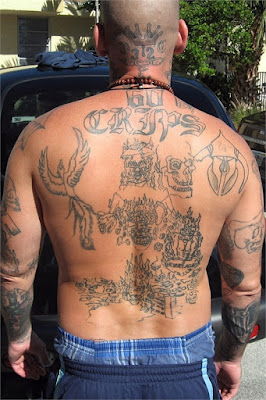 |
| (Gang Signs: Crips) |
The Crips have several symbols and hand signs with which they identify themselves. Some Crip sets will use six-point stars, six- and three-point crowns and the number 6. Some gang sets and/or members will place a distinctive dot on each point of the graffiti or tattooed pitchfork, which stands for Mi Vida Loca (“My Crazy Life”). Back-to-back letter C’s have also been documented as being unique to some sets. This could be perceived by some to be inaccurate and a sign of disrespect.
Crip gangs’ style of dress favors the right-hand side. Members and associates will roll their right pant leg up, wear their hat turned/tilted to the right, and “flag” (throw their gang signs) to the right. Their primary hand sign is the Crip “C,” and their primary color is blue. However, there are deviations, such as the Grape Street Crips in Los Angeles who use purple.
Bloods
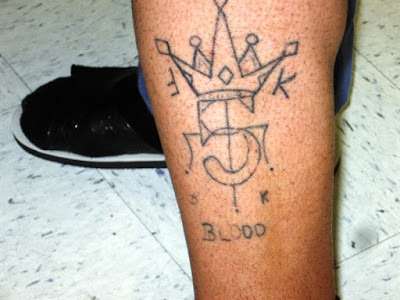 |
| (Gang Signs: Bloods) |
The Bloods also have several primary symbols and hand signs with which they identify themselves. Some Blood sets will use the five-point crown, the five-point star and the number 5. The Bloods’ primary color is red, which is relatively consistent. Use of the term “Piru” is synonymous with Blood. Less commonly, the Bloods use the crescent moon, which represents the splitting of the Black Nation into the East and the West.
Blood gangs emphasize the left-hand side in their style of dress. Members and associates will roll their left pant leg up, wear their hat turned/tilted to the left and “flag” to the left. Their primary hand signs are the “b” for Blood and the word “blood.”
Folk
The Folk Nation (All is One) has several primary symbols and hand signs that it uses to identify itself. The most recognizable is the three-pronged pitchfork, which is the Nation’s power symbol. Some gangs will place the initials of their set on top of each point. The six-point star, also referred to as the Star of David, corresponds to the Nation’s six primary beliefs: Life, Love, Loyalty, Knowledge, Wisdom and Understanding (L, L, L, K, W, U).
The six-point crown and anything pertaining to the number 6 also correspond to these beliefs. The sword symbolizes life and death within the Nation and its struggle to survive. The devil’s horns, usually seen on the top of the Folk heart, symbolize the Nation’s determination to overcome all obstacles. The heart symbolizes love of the Nation.
Folk Nation gangs emphasize their style of dress to the right. Members and associates will roll their right pant leg up, wear their hat turned/tilted to the right and “flag” to the right. Colors vary from set to set. Their primary hand signs are the pitchfork and six-point star.
People
The People Nation (All is Well) has several primary symbols and hand signs with which it identifies itself. The most notable are the five-point crown, which corresponds to each of the Nation’s five primary beliefs—Love, Loyalty, Wisdom, Understanding and Knowledge—and the five-point star.
The People Nation uses several other symbols. The pyramid and its three corners represent physical, mental and spiritual knowledge. The pyramid has 21 bricks, which is highly symbolic to the People. The eye seen in their graffiti is the eye of Allah watching over them. The hat represents shelter, the cane represents the staff of strength and gloves represent purity.
People Nation gangs will emphasize everything to the left. Members and associates will roll their left pant leg up, wear their hat turned/tilted to the left and “flag” to the left. Their colors vary from set to set.
 |
| (Gang Signs: People) |
Simple Codes
 |
| (Gang Signs: Insane Gangster Disciples 974) |
Many Crip and Blood sets use less complex/symbolic graffiti and tattoos than the Folk and People Nations, which is easier to identify in some cases. They will also deviate from the standardized, symbolic manner of dress to which most Folk and People Nation gangs adhere.
A simple code used by criminal street gangs is the substitution of specific numbers which correspond to particular letters of the alphabet (e.g., 1=A, 2=B, 3=C, etc.). An example would be the Insane Gangster Disciples who use 974 (I=9, G=7, D=4). There are also more complex codes and alphabets that are used to conceal messages.
Many gangs, gang members and associates will have “bibles” or documents with the gang’s rules, codes, alphabet and symbols. These documents could be the formal or informal rule book, or simply a gang member’s notebook or school book with gang symbols drawn on it. In either case, it can be documentation of gang activity, membership or association.
Symbol Inversion
Street gangs routinely use graffiti to challenge and disrespect rival gang sets and nations. Gangs will post their symbol but invert, break and/or cross out the rival gang’s or nation’s symbol. They will post derogatory gang terms like Crabs, Slobs, etc. They will usually do this in a conspicuous place so the challenge is clear and they attain notoriety in that neighborhood. It is important to identify new graffiti and remove it. A new challenge is usually indicative of an imminent problem, one that should be anticipated and addressed.
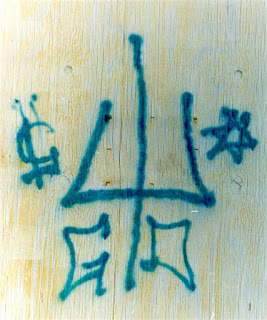 |
| (Street gangs graffiti (1)) |
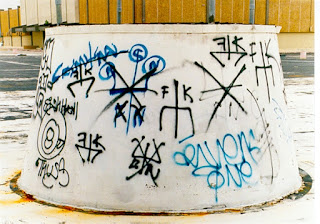 |
| (Street gangs graffiti (2)) |
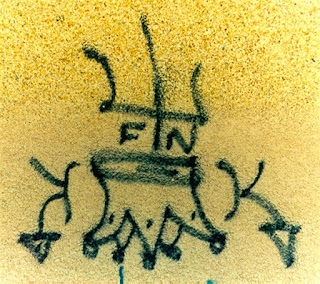 |
| (Street gangs graffiti (3)) |
The key to identifying criminal street gangs is having an open mind. Graffiti/symbol recognition and translation, field interviews, intelligence gathering and exchange, and training are a foundation. Gangs have continuously evolved and expanded since law enforcement realized they weren’t just street fighters, but a significant criminal threat to public safety.
Clothing
Clothing is a strong signal that all gangs show. The clothing gangs wear allows rival gangs to identify who is friend and who is foe. For example, the uniform for Hispanic gangs are standard and easily recognizable. Gangs such as the Latin Kings would wear long white T-shirts, baggy pants, and either a bandana or a hat, sometimes both. Black gang members are individualistic with their clothing. The gang would wear a specific clothing and certain accessories that would match their crew's colors. Examples include the Bloods and the Crips. The Bloods gang color is red so to identify themselves, they would wear red, whereas the Crips gang color is blue.
Bandanas
Bandanas can be worn in various types of colors and ways. This is done by gang members to signify which gang they are affiliated with. The most popular bandana colors are red, blue, black, white, grey, and yellow. It is typically worn on the head or in the left or right back pockets of gang members.

